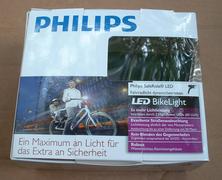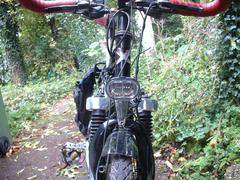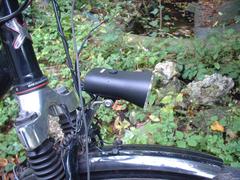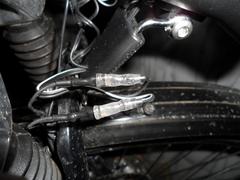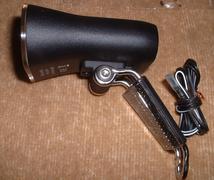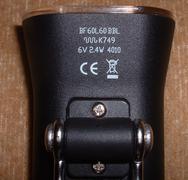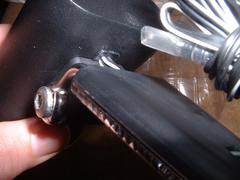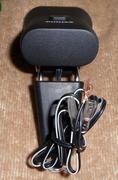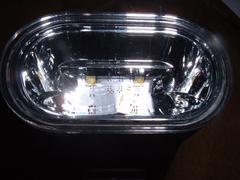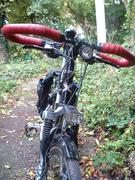Philips Saferide 60 (old name: Saferide LED dynamo)
See also: Modifications and dissection of a Philips Saferide 60.
'Saferide LED dynamo' is quite long so I abbreviate it to SLD, but I will probably simply use the new name 'Saferide 60' in future.
Preliminary
The dynamo version of the Philips LED bike light: I had read about the Philips LED bike light in late 2009 in a magazine, which also mentioned that a dynamo version would be coming in 2010. After seeing early beamshots of the Philips LED bike light in February 2010 (on snow, so not all that informative on how good the lamp really was, but it was promising) I was really curious, mentioned the possible dynamo version on this webpage, and asked Philips but got nowhere with either Philips-germany (which didn't respond at all) or Philips-NL (which gave useless responses); this sort of thing is typical for large companies where emails are presumably going in an endless loop, nobody knowing who to forward it to, or something like that... I then got talking to someone about bicycle lighting who has the battery powered LED light, but he wasn't that impressed with it (for in city use, and there are reasons for this, I'll explain more at a later date, but one reason was the weird artefacts in the beam), and in due course I got his Philips LED bike light on loan. I knew the LED bike light would give a lot more light than a Cyo/Edelux (it has 2x 3 Watt LEDs) and the beam pattern seemed to be better (wider, longer) from the information from various sources. The reality was far better than my expectations as you can see in my review of the Philips LED bike light. Note that powering a 6 Watt lamp with a dynamo isn't really a problem as long as the cyclist is going fast enough; it depends mostly on the electronics for the LEDs, so having a lamp such as this dynamo powered is possible... When I came across an exhibitor list of Eurobike, Philips was mentioned as introducing a new bikelamp, so I knew something was going to be introduced and then, on 2010-9-1: On Eurobike 2010, Philips released 3 new bicycle lamps, all similar to the LED bike light, including a dynamo version. I got confirmation from someone who went there. And the best part was that I was going to get a dynamo lamp to review. Cool!
I knew from the information from all sources that the dynamo version is smaller (with a smaller reflector) and not as bright as the LED bike light, but I hoped it would be be better or at least proper competition for the Edelux/Cyo, with more light close to you (near-field illumination) and a bit wider beam. In the Eurobike listing, the eBike version is mentioned as being 150 lumen, but I think this should be the dynamo version as the eBike is elsewhere mentioned as being 180 lumen. So presumably the dynamo version is 150 lumen.
If that's correct, the light output of the "SafeRide LED Dynamo" is similar to the Cyo (ca. 150-160 lumen at 30 km/h) and a little less than the Edelux (ca. 180 lumen at 30 km/h) which is a bit disappointing as the Edelux has been at this light output level for 2 years. I really wanted the LED bike light as a dynamo lamp, with the same light output (ca. 270 lumen)! Perhaps this is due to a rule of StVZO, namely that non-standardized light sources (such as LEDs) must be non-replaceable (or better said: Not easily replaceable, so more or less fixed in the headlamp) and headlamps with such non-replaceable 'bulbs' must be 2.4W for a 6V system, or 5.0 W for a 12V system (in a range of 0.80 x to 1.10 x (-20% to +10%)). I have the latest versions of StVZO and TA (Technische Anforderungen) and I'm checking to see what the rules say precisely. Btw., absurdly in this day and age, the regulations can't just be downloaded for free...
And now to the review: On 22 October 2010 I received the Saferide LED dynamo from Philips-Germany (thank you!). Test results and a comparison with the Edelux followed the same day, beamshots a few days later...
Experiences
First impression 22 October 2010: Not as much light as the 'LED bike light' but I knew beforehand it wouldn't be that bright. Throw is probably about 45-50 metre, the beam lights up a fairly wide path but not as wide as the battery version. I think the Edelux lost its crown as the best LED bike lamp with cutoff for dynamo, but it's close. Side by side tests to be done, so this is just an impression at the moment. What's noticeable is how flicker free the light is from very low speed. Not sure if this is done by not giving light output at very low speed or by reducing light output to allow a smoothing capacitor to do its work with little power coming from the dynamo. I'll have to compare side by side with the Edelux later tonight...
Throw: after testing some more, perhaps it's more than 50 m, it depends a bit on how the lamp is pointed. I'll check again next time. Furthest retroreflecting object on my test course (I only checked on the way back): 380 m, close to the furthest I ever got on many rides with the Edelux of 430 m. The lamp doesn't have a sensor to automatically switch on/off, but that's not a disadvantage compared to the Edelux as there the light goes on even if slightly overcast, or on sunny days even when riding in the shade of a car on the side of the road, for example, so for me the sensor is useless in the Edelux. The standlight switches off when you switch the lamp off, similar to newer versions of the Cyo. There's quite a bit of light at the front wheel, then a very short distance where it's a bit darker, then again bright. What I needed to get used to is seeing 2 shadows of the front wheel (due to the 2 LEDs)!
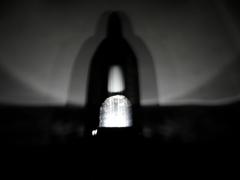
The near field light is good enough to put your bike away in a dark shed, contrary to the Edelux whose standlight is useless for that purpose. All in all I think I like the Philips lamp a bit more: It seems hardly less bright (I think it's a little less bright at long distance, ca. 40m, but I need to check that), with a slightly wider beam and more light close to you. Bad points: The lens at the front lets light go straight towards you, on the next ride I will put a piece of black tape on it. Then the mounting bracket: I'm not sure I like this and I'm not sure the lamp stays fixed with the right angle when riding over bad roads/bumps. The lamp is pretty heavy so on bad roads it vibrates a little bit on the bracket. Light flickering: Actually, it's pretty similar to the Edelux which also has very little flickering. I think with the Philips lamp it stood out because you see the light through the sides of front lens, which you don't have with the Edelux so there you only notice the light from reflections etc. which is usually once you're going at more than 10km/h.
Black tape applied to the Philips lamp to prevent reduction of nightvision:
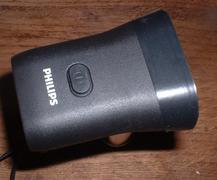
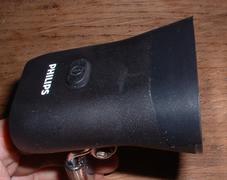
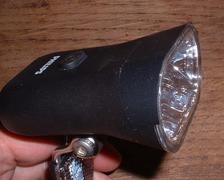
23 October 2010: Ride in the wet: It's hard to say which is better, Edelux or Philips. I think there could and in future versions should be a slight change to the reflector: There's a little bit too much light right on the front wheel, followed by a darker spot that's about 1.5 metre long. If that could be made more homogeneous, and slightly less bright than what it now is at the front wheel, it would improve the lamp a lot. If one considers price, the Philips lamp at the moment seems better value than the Edelux and Cyo: Better construction than the Cyo, about as good as the Edelux (performance and housing), for the same price as a Cyo.
The mounting bracket's inner hex bolts aren't actually standard and they don't thread into the plastic but as I suspected into each other (see one of the pictures below). The cables that go to the dynamo and the cable that ends in 2 connectors into which you can plug in the cable for the rear lamp (standard 2.8 mm flat plugs) go via the retroreflector which is neat. The plastic holder at the bottom of the lamp doesn't have the more usual 10 mm width, but about 21.8 mm. Removing it shows that further dissection of the lamp is not easily possible as that's the only opening other than where the reflector and front glass go. This means these are pressed in or glued in after the electronics are put into the lamp. This may be because of the StVZO requirements, that a light source that's not of standardized type (only incandescent bulbs are standardised), must be fixed. So, not being easy to open may be an implicit rule... Thinking a bit more about this: The LED bike light can be opened, changed easily and then it won't be StVZO compliant any more, so perhaps there's another reason. I prefer it if equipment can be opened and thus repaired/maintained (or modified!) by those who want to, and if that's not possible that lowers its rating a bit for me (this is so for Philips' dynamo lamp, but also the Edelux is which is very hard to open without damaging it).
Here are some pictures of how far you can get dissecting it (without risking damaging it):
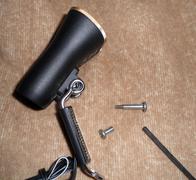
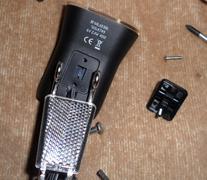
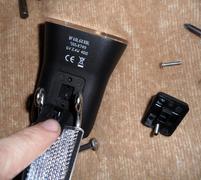
Mounting bracket: After various rides and proper tightening on the bike's fork crown bolt (also, I used a slightly longer bolt that properly threads into the plastic in the retaining nut as for use with the mounting bracket of the Philips lamp it was slightly too short) it didn't shift sideways any more, also the 2 bolts in the lamp itself to set its angle need to be tightened more than I wanted to do at first (not wanting to damage anything).
Cable to the rear lamp: I'm not too fond of 2.8 mm plugs because they're fairly vulnerable (the female plug will quickly break after bending). In this respect a loose cable as used in the Cyo and now the Philips SLD with 2.8 mm male plugs is better than the connector in the Edelux (which is kept relatively safe if it stays in the lamp's aluminium housing that surrounds the male connector, but these connectors can get loose a bit over time, come out, and be in danger of bending) but it's esp. better than the Lumotec oval where the female plugs are quite exposed. The reason is that there's very little chance of plugs bending when they're not fixed to a nearly immovable object...
The on/off switch works ok, but when it's cold (less feeling in your fingers/hand) it's hard to press it correctly, the Edelux's rotating switch is better.
Beamshots
See this separate page about camera settings, lamp settings and roads used to make the beamshots.
On road 2 (rough asphalt)
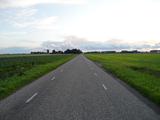
Note: the first 1.05 m beamshot is too dark, see this explanation.
Location: Road 2, Camera height: 1.80 m, Settings: F3.5, ISO 80, 4s, Camera: Samsung ST70
| Lamp height: 0.75 m |
Lamp height: 1.05 m |
0.75m
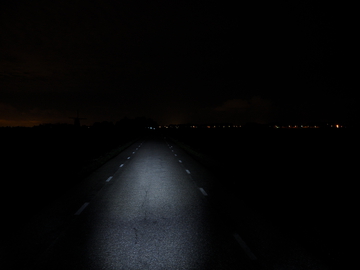
|
1.05m
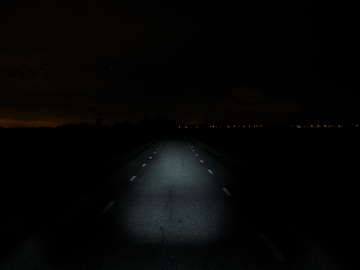
|
| |
1.05m (this replaces the above image, the lamp is now angled properly)
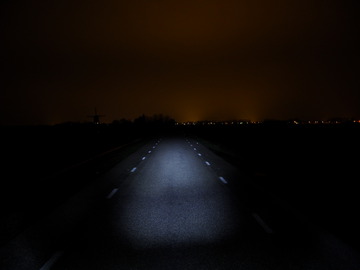
|
On road 3 (reddish asphalt)
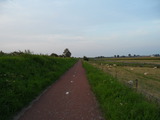
Beamshots on road 3: Camera height: ca. 1.55 m, camera aim: 2nd marker at 50m, position: 0.60m behind the lamp. There are some small white sticks (not retro-reflecting) on the ground at 10 m and 15 m distance on the left and right side of the road.
| Lamp height: 0.75 m |
Lamp height: 1.05 m |
Philips Saferide LED dynamo |
0.75m
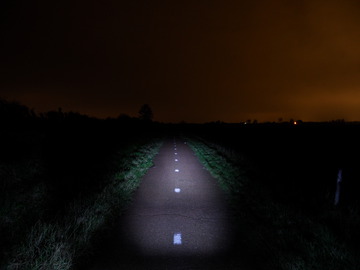
|
1.05m
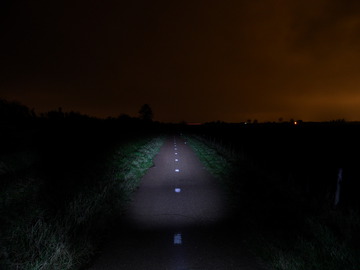
|
0.75m, aimed far
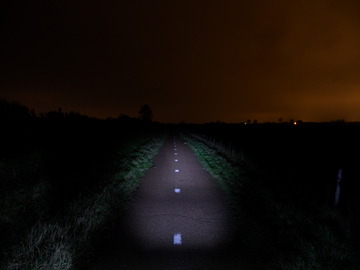
|
Pictures of the beam pattern close to the front wheel
[ Lamp height: ca. 1.05 m, camera height: ca. 1.80 m pointed downward in the second picture, F3.5, ISO 80, 4s, camera: Samsung ST70, (N.B.: 14 megapixel images) ]:
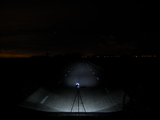
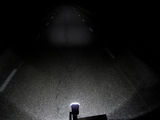
Update 2011-5-18
The lamp mount is not vertically stiff enough for use on brick roads where it vibrates a lot (when the tyres are pumped to about 4.5 bar or more). Perhaps related to this, something got loose in my lamp (in use since Oct 2010) and the standlight sometimes doesn't work unless I give the lamp a little knock. I will let Philips know about this...
2011-7-30: I have heard of several cases where the lamp mount broke in the section where it's flattened. This hasn't happened to my lamp, despite long use, possibly because I use a stainless steel washer that goes over the edges of the flat section, which possibly acts as a stress relief towards the edge. I therefore recommend using a big stainless steel washer. I further heard from someone in NL who had a broken lamp mount and contacted Philips about it, that a new version of that mount was coming. Whether that is to be made available loose, or with the current series of lamps I don't know, perhaps it will be used in a new generation of headlamps? If Philips had just used a standard 10 mm mounting width underneath the lamp, then any other standard lamp mount could be used without having to do some DIY... There is a thread on candlepowerforums about the Philips SLD, but I removed the link as I boycott this forum since Feb. 2020 (see The issues with forums, moderators: An example: Moderators on candlepowerforums) [ you won't miss anything, this review is enough, and the SLD/Saferide 60 is no longer available. For those interested, the Spanninga Axendo 60 uses the same reflector but with cool white LEDs. ].
Conclusion
I think I like it just a bit more than the Edelux in particular, and at a far lower price at the moment I currently consider this lamp to be the 'best value for money'. What I don't like about it is the light from the lens that goes directly to your eyes (you can fix that with some black paint or black tape, this is why you should buy the lamp in black, not gray as then you need to find the matching gray paint!) and that there's too much light close to the front wheel. The latter may be a reason to choose another lamp for the picky riders among us (Note: 23 Dec. 2010: But there are virtually no alternatives, the Supernova E3 pro-StVZO that I'm testing at the moment is only better in this respect, not really in beam pattern elsewhere nor the amount of light). For more details on the how the Philips SLD, Edelux and E3-pro-StVZO compare see my review of the E3-pro-StVZO.
Btw., this lamp is finally available in a few german webshops since approximately the end of December 2010.
I will end with my wishlist for improvements in this lamp:
- Neutral white LEDs instead of 'crystal' white (see this page for why).
- The lens shouldn't let light go upward, this diminishes your night vision. Sticking a bit of black tape on top is what you should do with the current lamp.
- A better lampholder, in particular it should be stiffer.
- Less light at the position of the front wheel, and a little bit more a metre or 2 further to give a more even distribution. [ Note: I've talked with someone who's working in this area (not from Philips), and this problem of a bright spot, then a darker spot, then again the beam gets brighter, is a common problem that lamp designers have, and is related to the limitations they're working with. So it's probably not the case that the people from Philips didn't want to see the same light distribution that I would like to see, but more likely that it's simply very hard to do this, esp. with a small reflector ]
- I'd like to see a sensor that one can set the sensitivity for, so that the lamp goes on at the desired light levels. This is really a general wish, not particular for this lamp. Note that I consider the sensor in the Edelux to be useless as it almost always goes on, even in bright sunlight when riding through a shadow of say a car, or if it's slightly overcast.
- Perhaps a slightly higher and not as long housing, which would make it look a bit better and perhaps would/could lose some weight as the lamp is pretty heavy (about 130 g with cables but without mounting bracket/reflector).
See also: Modifications and dissection of a Philips Saferide 60.
Last modified: Thu Dec 20 04:25:25 CET 2012
